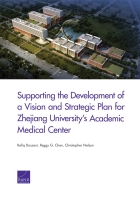| 来源类型 | Research Reports
|
| 规范类型 | 报告
|
| DOI | https://doi.org/10.7249/RR2819
|
| ISBN | 9781977401960
|
| 来源ID | RR-2819-ZHU
|
| Supporting the Development of a Vision and Strategic Plan for Zhejiang University's Academic Medical Center |
| Rafiq Dossani; Peggy G. Chen; Christopher Nelson
|
| 发表日期 | 2019
|
| 出版年 | 2019
|
| 页码 | 70
|
| 语种 | 英语
|
| 结论 |
Potential models of organization vary- The key domains of an AMC organizational structure that have the potential to distinguish AMCs from one another are ownership and identity, governance and operations, and finances.
- Four models were identified with variations in these domains that could reasonably be considered by ZJU for governance of the new AMC.
- In all four models, ownership is divided between the university and the hospital (while governance is shared), but the models differ in where their identity lies and who holds operational control.
Two models stood out as having the most potential- The university-led model would achieve the highest level of performance on attributes that measure progress toward the ZJU AMC goals.
- The AMC-led model also achieves the desirable attributes of the university-led system but primarily within the AMC.
- Both models entail significant start-up costs and time commitments compared with some of the other models considered.
- The two models also entail a certain organizational vision that recognizes that ownership may be separate from governance, which in turn may be separate from operations control.
- A key aspect of organizational vision is the importance of a unified identity: the university.
Support from the government and private donors is crucial to the AMC's success- The government's role will be necessary at different levels — provincial, municipal, and district. Government support is needed to ensure that costs are met and to fulfill the vision of a unified health system under the university's identity.
- Donors add to the hospitals' main sources of revenue.
|
| 摘要 |
- The two recommended models are: a university-led model, in which the AMC adopts the identity of the university and is operated by the university; and an autonomous model (or AMC-led model), in which the AMC adopts the identity of the university but operates independently.
- We do not recommend consideration of a hospital-led model, in which the AMC adopts the identity of the hospital and is operated by the hospital; or of a shared model, in which the AMC adopts the identity of the university and is operated jointly by the hospital and the university.
- Ongoing monitoring and measurement are key to the success of the ZJU AMC, and they should be initiated in parallel with the initiation of implementation plans for the new model.
- Monitoring the progress of a selected organizational model should be systematic, utilize different types of data and data sources, and focus on both long-term goals and short- and mid-term goals.
- No matter which governance model is ultimately selected, there are likely to be unanticipated barriers that will require adjustments to the model even as progress continues.
- Together, all these factors will ensure the presence of learning and feedback loops that can guide ZJU in making midcourse corrections.
|
| 主题 | Biomedical Research
; China
; Health Care Education and Training
; Medical Professionals
; Organizational Leadership
; Public Sector Governance
|
| URL | https://www.rand.org/pubs/research_reports/RR2819.html
|
| 来源智库 | RAND Corporation (United States)
|
| 引用统计 |
|
| 资源类型 | 智库出版物
|
| 条目标识符 | http://119.78.100.153/handle/2XGU8XDN/108964
|
推荐引用方式
GB/T 7714 |
Rafiq Dossani,Peggy G. Chen,Christopher Nelson. Supporting the Development of a Vision and Strategic Plan for Zhejiang University's Academic Medical Center. 2019.
|
|
文件名:
|
1551364880314.jpg
|
|
格式:
|
JPEG
|

|
文件名:
|
RAND_RR2819.pdf
|
|
格式:
|
Adobe PDF
|
除非特别说明,本系统中所有内容都受版权保护,并保留所有权利。